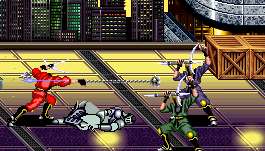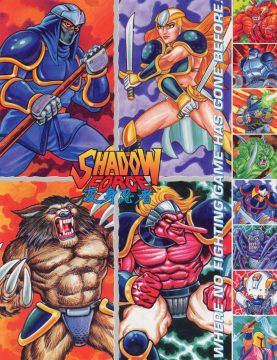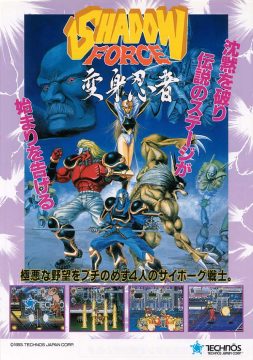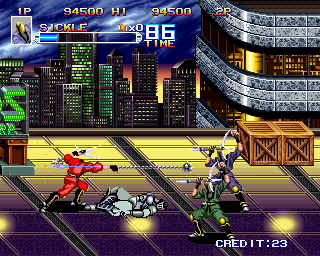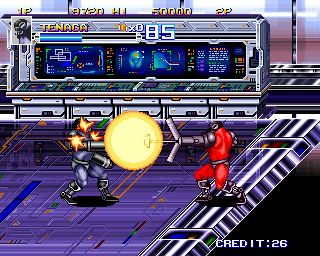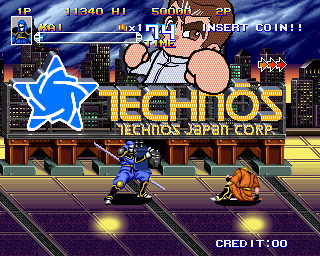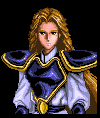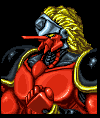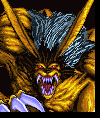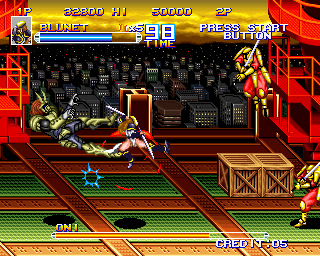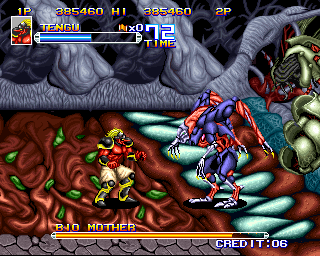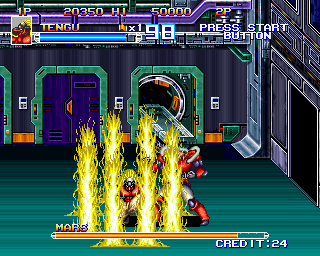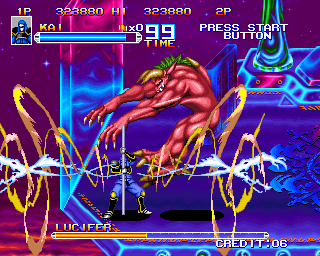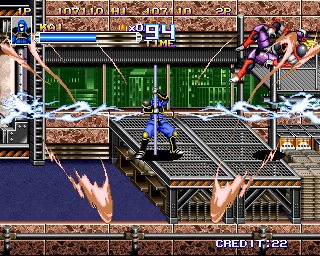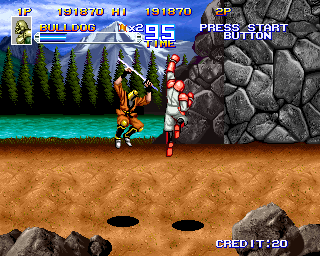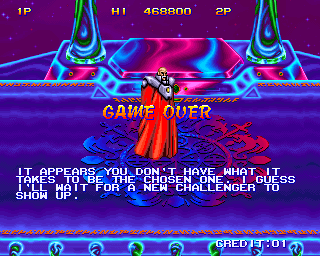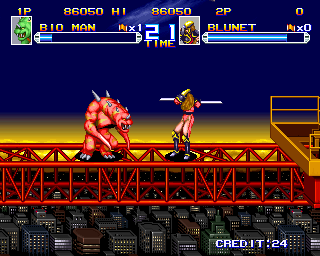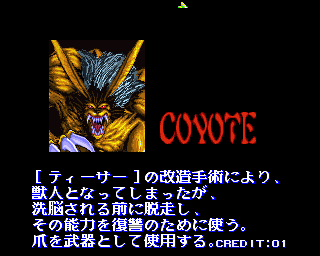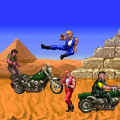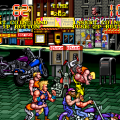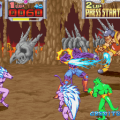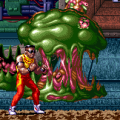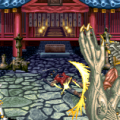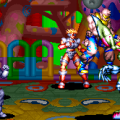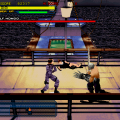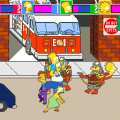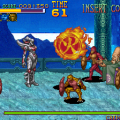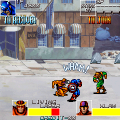When it came to beat-em-ups, Technōs was never content to simply rehash a formula again and again. They were always taking risks and experimenting with weird ideas, and there’s often a great deal of variation from game to game. Double Dragon was completely reinvented once in beat-em-up form (or twice if you count Double Dragon 3, which Technōs didn’t develop, but did port to NES), and Kunio-kun / Nekketsu High School has at least four very different incarnations throughout its half dozen beat-em-ups.
Double Dragon and Nekketsu High School make up the bulk of Technōs’ beat-em-ups, so it’s interesting to see what experimentation they did in other games. Their most well known “other” beat-em-up is called The Combatribes, which is kind of like a re-visitation of, and massive improvement on, the ideas they worked with in Renegade. Their only remaining beat-em-up is a virtually completely forgotten arcade game called Shadow Force.
Shadow Force‘s plot concerns an organization called Teaser that’s led by a guy named Mr. Wong, who looks kind of like Sigma from Mega Man X. He’s creating monsters to take over the world, and the four heroes are out to attempt to bring an end to his plans. Your quest takes you through chemical plants, forests, and across roof tops, before making your way through a very bizarre looking fourth level. At the end of the fourth level, you fight a giant monster that, after being defeated, swallows your character whole. The fifth and final level is then set within the monster itself. Either being swallowed by this thing reduces everything in size, or the monsters’ innards don’t answer to the laws of physics, because it’s absolutely huge in there. Even Mr. Wong makes an appearance at the end of the level, where he tells you that you’ll have to face his most powerful creation, which he strangely keeps hidden inside another of his monsters.
Two people can play Shadow Force at once, and there are four characters to choose from.
Characters
Kai
A rokushakubo-wielding ninja who is the last descendant of the “Iga” clan. He suffered a serious wound during a previous battle and became a cyborg soldier. He’s probably the closest to a “balanced guy” character.
Blunet
The sole female member of the group. Wields two swords. Although she is the only one who still has her human flesh, her fighting abilities are just as good as the other three members. Apparently she is waging a war against pants.
Tengu
A cyborg soldier who has a crimson-colored body and a face like the mythical “tengu” from ancient Japan. Fights using his bare hands. He was once the leader of a resistance movement. He’s a rare beat-em-up grappler with several good throws.
After choosing your character, you get to choose your first level out of any of the first three. Which level you play first decides the order of the second and third levels, and then the fourth and fifth are always played in the same order.
Many of Technōs’ beat-em-ups are more complex overall Capcom’s or Konami’s, despite featuring relatively simplified control setups involving merely two or three buttons. Shadow Force represents the complete opposite approach, and has possibly the most complicated mechanics of any beat-em-up ever made. Rather than a standard beat-em-up control setup of two buttons, Shadow Force has a whopping six buttons. It’s actually setup very much like a fighting game, with two buttons for weapon strikes and punches, and two for kicks, each performing an attack with different range, speed, and strength. Making things even more like in a fighting game, you can execute a low strike by holding the joystick in the down position and attacking, or a strike that hits high by holding the joystick in the up position and attacking. The fifth button executes a jump, and there are three attacks that can be performed after a jump by pushing either punch/weapon, kick, or weapon/punch with the joystick in the down position. You also have a limited stock of full screen bombs that are released by pushing both of the strongest kick and weapon/punch buttons at once. It’s also possible to grab characters and throw them by pushing any attack button.
You can even perform two specials for each character. Everybody except Kai has a special performed by moving the joystick from back to forward, followed by the stronger of the two weapon/punch buttons, but there are other commands as well. A few specials are blatantly stolen from fighters or other beat-em-ups – Tengu can perform a spinning clothesline like Haggar, Coyote has a ripoff of Blanka’s body projectile, Blunet can perform a Hurricane Kick equivalent like in Double Dragon, and Kai can rapidly attack with his weapon like several Samurai Shodown characters. And, like most fighting games, your character will always face their nearest opponent, and holding the joystick in the backward position will allow you to block enemy attacks. Even the way that characters are differentiated from each other is more like in a fighter – each nuance to their movesets is what defines them – instead of just having varying levels of speed or strength.
Of all the ideas in Shadow Force, the most interesting of all is that you have the ability to possess most normal enemies by pushing the sixth button. Your character will disappear, and then you’ll be shown how to perform the enemy character’s special move. These range from a Guile-style Flash Kick for Katze, to a Dragon Punch for Bulldog, to firing a machine gun for Rifle – among others. There are about ten characters that can be possessed in total, and each has their own movesets, though they generally consist of less moves than the main characters have. A few of these enemies have moves that are easily as good as any other in the game, like a dashing uppercut or the ability to throw a grenade. If you lose all you health while possessing an enemy, you”ll revert to your original form, or you can also revert back by just pushing the possess button again. Another point where you can control the villains is during the fighter sections after each level. After beating every level – even the last – you’ll get to choose from a multitude of enemy characters and fight a match on a bridge against a computer controlled foe, or your teammate if you’re playing with a second player. If you are playing alone, this is strictly for points, and nothing happens if you lose, but if two people are playing, the loser also loses their credit.
It’s always great to have large movesets for a beat-em-up, and Shadow Force‘s dozen and a half or so is possibly the largest total of moves for any game in the genre. However, in practice, there is not as much variation in your moves. You do need to attack low to break open crates, and attacking high is great for hitting jumping opponents, but against standing foes your attacks are mostly just different versions of the same types of attacks, instead of completely different kinds of moves. In all fairness, they do differentiate in speed, range, and strength, so you are rewarded, at least to an extent, for learning which moves work best when. The obscenely large movesets mean that there are several combos that can be executed, but they don’t really differentiate from each other in any relevant way, and amount to little more than button mashing. The difference between high, low, and mid-level moves could have been made much more significant if each kind had to be defended against differently, but there aren’t any hit levels, so blocking works identically against every attack.
Another problem with Shadow Force is its difficulty, especially late in the game. It’s never easy, but when you get to the last few bosses it can be a real task to get more than a few hits in without continuing. What’s worst of all is that there’s little you can do about this. Your attacks (excluding bombs) do very little damage against bosses, so the later bosses will take a while to defeat if you don’t continue to replenish you supply of bombs. As a result, you are virtually forced to spam specials against bosses to have any chance. Throughout the game, normal enemies will block your attacks fairly well, and they get better as the game progresses. These points would all be moot if you had techniques that allowed you to deal with these things more efficiently, but you really don’t – your movesets don’t allow you to do as much as you might expect, given their immense size. The ending of the game is a pain in the ass as well – it’s a fighter section, like you play after every level, but you just get a Game Over if you lose it, rather than any kind of ending. The worst part is that while its entirely beatable, it’s still fairly challenging, and there’s no continuing after losing the match. Playing the game with two players does make Shadow Force a bit easier, of course. If you can pull of the miracle of finishing the game, the ending differs for each character.
Shadow Force might actually be Technōs’ best looking beat-em-up ever, as the level of detail is exceptional. The roof top stage has a freaking awesome neon Technōs sign that changes color. Its actual designs are a bit scatter-shot, in a good way – nothing really seems to go together, but it all looks pretty nice. The best designed level by far is the forest level, which has several fantastic looking huge waterfalls and a gorgeous looking long shot of a river bank. Its music is probably what you’re least likely to remember about the game, but it’s okay for what it is.
The Japanese release has several differences from the American version. Most significantly, there are only three buttons – jump, kick, and weapon/punch – so you only have half as many attacks. It seems like a really horrible idea to reduce movesets in a beat-em-up, but several of the game’s attacks are too similar to be absolutely essential, so it really isn’t a problem. As there’s no longer a specific button for it, possessing enemies is performed by pushing both attack buttons at once. Also, the command to release your bomb has been changed so that you have to push all three buttons.
Another change is that those fighter sections have been removed entirely. This also means that it’s possible to finish the game with two characters, and there are extra endings for each possible pairing. Yes, this release does have less content, but if you’d rather avoid the fighter sections, and you find the movesets to be more convoluted than genuinely beneficial, then you might actually prefer this version. There’s also a totally insane message before the intro telling people not to be bullies below an image of that neon billboard of Kunio. Yeah, not the best way to get a point across – the character that originated the beat-em-up genre, in a beat-em-up game, by the developer that invented beat-em-ups, telling everybody not to beat people up. Additionally, there’s a short intro detailing the plot, as well as providing character portraits and bios.
Shadow Force has never been ported, given a sequel, or anything. Given how obscure it is, it’s likely that it wasn’t very popular in the arcades. It does have a few flaws, but it plays well and has an extraordinary amount of fresh ideas in a genre that has always had far too few genuinely original games. Given that Technōs often polished and implemented their ideas in later games, it would’ve been interesting to see what they might have been able to do with these ideas if they kept making this type of game. Maybe we would’ve seen a Kunio game where you could control your enemies, or a Double Dragon with hit levels or something. Anyhow, it’s interesting to look back today on what remains among the most novel games in the genre, and to play a forgotten beat-em-up by, arguably, the genre’s greatest and most innovative developer.
Thanks to Johnny Undaunted for the profile and story translations.
